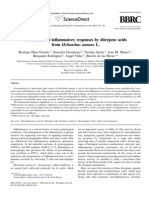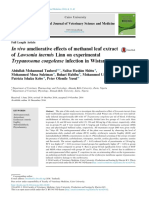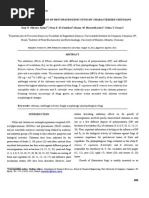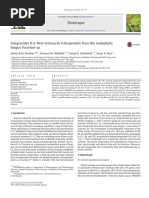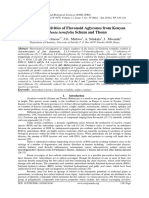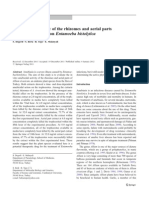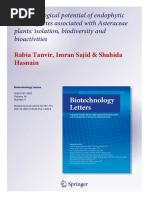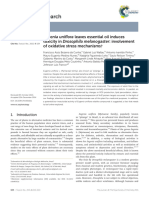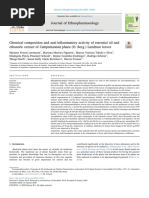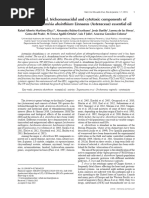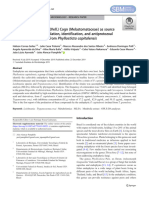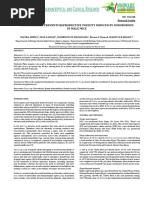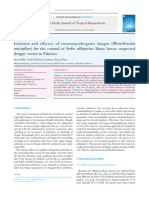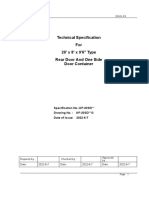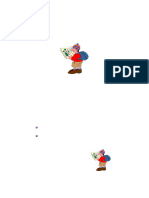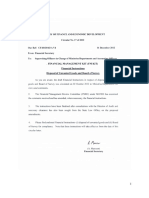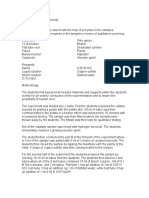JNatPharm23133-3853922 104219
JNatPharm23133-3853922 104219
Uploaded by
Juliana NarcisoCopyright:
Available Formats
JNatPharm23133-3853922 104219
JNatPharm23133-3853922 104219
Uploaded by
Juliana NarcisoOriginal Title
Copyright
Available Formats
Share this document
Did you find this document useful?
Is this content inappropriate?
Copyright:
Available Formats
JNatPharm23133-3853922 104219
JNatPharm23133-3853922 104219
Uploaded by
Juliana NarcisoCopyright:
Available Formats
Journal of Natural Pharmaceuticals, Volume 2, Issue 3, July-September, 2011 133
Address for
correspondence:
Prof. Dr. Marise M. O.
Cabral, Vectors Insect
Laboratory /CECETEN,
Education, Research
and Extension Unit
Prof. Antonio Orlando
Izolani, Severino Sombra
University, Av. Exp.
Oswaldo de Almeida
Ramos, 280, Vassouras,
27700-000, RJ, Brazil.
E-mail:
mmaleck@oi.com.br
Laboratrio de Insetos
Vetores, Universidade
Severino Sombra, Avenida
Expedicionrio Oswaldo de
Almeida Ramos, Vassouras,
RJ,
1
Departamento de
Qumica-ICE, Universidade
Federal Rural do Rio de
Janeiro, Instituto de Cincias
Exatas, Seropdica, RJ,
2
Laboratrio de Bioqumica de
Tripanosomatdeos, Instituto
Oswaldo Cruz, Fundao
Oswaldo Cruz, Av. Brasil, Rio
de Janeiro, RJ, Brazil
Flavonoids inhibited NADPH consumption and ecdysis processes
in Oncopeltus fasciatus
Juliana Oliveira Abreu Narciso, Marco Antonio Soares de Souza, Mario Geraldo de Carvalho
1
,
Mrio Sergio da Rocha Gomes
1
, Marcelo Genestra
2
, Marise Maleck de Oliveira Cabral
ABSTRACT
Background: Piptadenia rigida is a source of avonoids such as isoliquiritigenin (1), 7,3,4-trihydroxyavone
(2) and 7,8,3,4-tetrahydroxyavanone (3). Flavonoids inuence on the feeding behavior of insects besides
the inhibition of the insect larvae growth. Nitric oxide (NO) seems to be conserved in invertebrate innate
immunity and the NO synthase (NOS) activity has been implicated in insect immunity. Therefore, the NOS
expression can be evaluated to determine the inhibition of NADPH consumption. Material and Methods:
three natural avonoids, isolated from P. rigida whose structures were determined by
1
H and
13
C NMR
spectral data analysis, were evaluated on the Oncopeltus fasciatus control by molting processes and NADPH
consumption in the insect intestine following mortality. Results: The avonoids treatment on O. fasciatus
showed 50% mortality and 50% ecdysis (1), 30% mortality and 43% ecdysis (2), and topical treatment with
3 resulted in 43% ecdysis but did not show high toxicity at 100g/nymph. Intestine homogenates obtained
from insects treated with avonoids that were incubated with NADPH substrate showed percentage inhibitions
of 72%, 78% and 80%, for the treatments 3, 1 and 2, respectively. Conclusion: The avanone (3) was the
most effective and least toxic to the insect, followed by 2 and then 1.
Key words: Bioactivity, Hemiptera, molting, NOS, Piptadenia rigida
INTRODUCTION
Co-evolution has developed plants with
a diversity of chemical defenses against
herbivorous insects. Plant derivatives
have been receiving increasing research
attention, and more than 2000 plant species
are already known to have metabolites with
insecticide properties, such as rotenone and
nicotine from Pyrethrum.
[1-3]
Phytochemicals
endowed with hormonal, anti-hormonal or
toxic activity are potential agents for insect
control.
[4,5]
Alternatives may be found among
natural sources, particularly among higher
plants, which provide a number of repellent
and secondary toxic metabolites.
[6]
Flavonoids have been shown to affect the
feeding behavior of insects
[7]
and to inhibit
the growth of insect larvae.
[8]
The avonols,
quercetin, rhamnetin and rutin, have been
evaluated in relation to their effect on the
growth parameters and food processing
efficiency of the southern armyworm
Spodoptera eridania C.
[9]
and Spodoptera
litura F.
[10]
Rutin was found to have third
trophic level effects on an invertebrate
predator of rutin-fed Manduca sexta
larvae.
[11]
A test on a series of naturally
occurring and synthetic avones, in relation
to the growth of the navel orangeworm
Amyelois transitella, showed that
unsubstituted flavones had the greatest
inhibitory effect.
[12]
Insects are known to possess efficient
mechanisms for combating pathogens
by building up defense responses. These
mechanisms exhibit striking parallels
with those of the innate immunity of
vertebrates.
[13]
Within the innate system,
constitutive and inducible components
can be distinguished. The constitutive
component serves as an early and continuous
physiological barrier. The current data
indicate that it includes various antimicrobial
or digestive peptides and proteins that are
constitutively expressed in the gut, pharynx,
hypodermis or secretory cells. In contrast,
the inducible component is believed to
Original Article
Access this article online
Website: www.jnatpharm.org
DOI: 10.4103/2229-5119.86259
Quick Response Code:
[Downloadedfreefromhttp://www.jnatpharm.orgonWednesday,October26,2011,IP:189.13.58.230]||ClickheretodownloadfreeAndroidapplicationforthisjournal
Journal of Natural Pharmaceuticals, Volume 2, Issue 3, July-September, 2011 134
represent a highly efcient but costly defense, such that
it is only activated after detection of pathogens or their
detrimental effects.
[14]
Reactive oxygen radicals and nitrogen intermediates are
the key immune effectors and signaling molecules in many
organisms.
[15]
Nitric oxide (NO) also seems to be conserved
in invertebrate innate immunity.
[16,17]
Nitric oxide
synthase (NOS) activity has been implicated in insect
immunity.
[16]
In the present study, bioassays were performed with
Oncopeltus fasciatus Dallas (1852), which occurs over a
wide range, extending from Massachusetts westward over
the greater part of the United States and southward to
Mexico and Brazil, as a convenient model for testing the
effects of avonoids on development and mortality. We
also hypothesize that NOS expression and NO production
in O. fasciatus may be modulated by avonoids. Thus,
we provide new insights into the possib ility of using
avonoids as natural compounds for insect control.
MATERIALS AND METHODS
Extraction and Isolation of Flavonoids
Roots of Piptadenia rigida Benth (Leguminosae
Mimosoideae) were collected from the Forest Garden of
the Forest Institute (Instituto de Florestas, IF) of the
Federal Rural University of Rio de Janeiro (Universidade
Federal Rural do Rio de Janeiro, UFRRJ), Seropdica,
RJ, by Dr. A. G. de Carvalho of the Department of
Forest Products, IF, UFRRJ. They were identied by
Prof. Dr. Jos Aguiar Sobrinho of the Department of
Environmental Sciences, IF, UFRRJ. The voucher
specimen (No. JPB-21438) has been deposited in the
UPR Herbarium, IB, UFRRJ. Powdered dried root
material from P. rigida was extracted exhaustively with
CH
2
Cl
2
and MeOH at room temperature. The solvents
were removed under vacuum to yield the residues
Piptadenia Rigida Roots Dicloromethane (PRRD)
(19.2 g) and Piptadenia Rigida Roots Methanol (PRRM)
(310.5 g), respectively. The extract PRRM was dissolved
in MeOH/H
2
O (8:2) and partitioned with solvents to
yield three fractions: hexane (H, 2.24 g), chloroform
(C, 11.9 g) and methanol (M). Fractionation of C on a
silica gel column with dichloromethane, ethyl acetate
and methanol yielded D (270.0 mg), E (6.3 g) and F
(5.3 g). The fraction E-8-13 was further fractionated
on silica gel CC using chloroform as the initial solvent
and then increasing the polarity with methanol; 50
fractions were collected and analyzed by means of silica
gel thin layer chromatography (TLC) plates. The fraction
E-8-13 (294.0 mg) was ltered on a Sephadex LH-20
column and the fractions were analyzed by means of
silica gel TLC plates. The fractions 1113 from this
ltration produced methyl 3,4-dihydroxybenzoate and
the fractions 1821 yielded a solid material that was
identied as iso liquiritigenin (1, 15.0 mg, m.p. 158159C)
[Figure 1]. The E fraction E-27-33 was then fractionated
by means of circular preparative chromatography (in a
Chromatotron) using dichloromethane/methanol (8:2),
and the pure fraction detected by means of the TLC
plate was identied as 7,8,3,4-tetrahydroxyavanone
(3, 22.0 mg, oil) [Figure 1]. The fraction E-45-53 was
then fractionated by means of preparative TLC using
chloroform/ethyl acetate (1:3), and the intermediate
fractions were reunited to obtain a crystalline material
that was identified as 7,3,4-trihydroxyflavone (2,
20.0 mg, mp 213214C) [Figure 1]. The structures
were identied by means of
1
H and
13
C [Broad Band
Decoupling (BBD) and Distortionless Enhancement
by Polarization Transfer (DEPT)] nuclear magnetic
resonance (NMR) spectra data analysis
[19a]
and
comparisons with data in the literature (1
[18]
2,
[19b,20]
and 3
[21]
).
Insects
The 5
th
instar nymphs (same aged) of O. fasciatus used
in this study were taken from a longstanding colony that
has been reared and maintained in the Vector Insect
Laboratory of Severino Sombra University, RJ. The
insects were given water and food (sunower seeds),
and they were maintained at 24.5 1C and 68 10%
relative humidity (RH).
Bioassay
The insects were deprived of water and food (sunower
seeds) for 24 hours before treatment and were maintained
under incubation in a biochemical oxygen demand
(BOD) at 24.5C . The avonoids 1, 2 and 3 were diluted
in acetone and dissolved in 0.15 M NaCl solution at nal
concentrations of 1, 10 and 100 g/L. The substances
were applied at a concentration of 1 L to the abdominal
ventral surface of each nymph. The bioassay of 10
nymphs/group of O. fasciatus was performed in triplicate
experiments with regard to the effects of avonoids. The
control groups consisted of acetone and 0.15 M NaCl
solution (without avonoids) and untreated solution.
Immediately after the treatment, the insects received
Figure 1: Structure of isoliquirigenin (1), 7,3,4-trihydroxyavone (2) and
7,8,3,4-tetrahydroxyavanone (3)
Narciso, et al.: Flavonoids inhibit NADPH and ecdysis on Oncopeltus fasciatus
[Downloadedfreefromhttp://www.jnatpharm.orgonWednesday,October26,2011,IP:189.13.58.230]||ClickheretodownloadfreeAndroidapplicationforthisjournal
Journal of Natural Pharmaceuticals, Volume 2, Issue 3, July-September, 2011 135
food and water and were maintained at 24.5 1C and
68 10% RH throughout the experiments. Mortality and
growth development of O. fasciatus were evaluated until
18 days after the treatment period.
Statistical Analyses
The results were analyzed using Tukey test with a
significance level of 5%
[22]
and analysis of variance
(ANOVA),
[22]
and the standard deviation was calculated
using the average of the experiments.
Preparation of O. fasciatus Intestine Homogenates
To measure NOS activity, the protocol proposed by
Ghigo et al.
[23]
was used with some modications. The
intestines of O. fasciatus were treated with trypsin/
ethylenediamine tetraacetic acid (EDTA) (0.05/0.02%
v/v; Sigma Chemical Co. St. Louis, USA.), washed,
resuspended at 10.0 mg/mL of protein in 2 mL of
4-(2-hydroxyethyl)-1-piperazineethanesulfonic acid
(HEPES) (pH 7.2; Sigma Chemical Co.) and sonicated
on ice with two 10-sec bursts. The protein content was
assessed spectrophotometrically (260280 nm). Protease
inhibitor buffer [0.1 mM phenylmethylsulfonyl uoride
(PMSF), 0.01% leupeptin, 0.2 mg/mL trypsin inhibitor
and 1.0 mM benzamidine] was added at a nal volume
of 5 mL,
[24]
and aliquots of the homogenates were checked
for NOS activity.
Spectrophotometric Measurement of NOS Activity
In each assay, intestine homogenate containing 200 g/
mL protein was mixed with the following reagents (all
from Sigma Chemical Co.) in a 400 L nal volume:
0.2 mM Nicotinamide adenine dinucleotide phosphate
-NADPH, 360 M L-arginine, 2 M tetrahydrobiopterin,
1.0 M Flavine adenine dinucleotide-FAD, 1.0 M
FMN, 0.3 mM CaCl
2
, 0.2 mM dithiothreitol and 50 mM
potassium phosphate buffer (pH 7.4). In some samples,
the constitutive NOS inhibitor L
-nitro-L-arginine methyl
ester (Sigma Chemical Co.), inducible NOS inhibitor
diphenyl-iodine chloride (Sigma Chemical Co.) and
avonoids (1, 2 and 3) were added. A solution of ketone
was used as a negative control and L-NAME as a positive
control. NOS activity was determined in the reaction
mixture by measuring the decrease in absorbance at
340 nm for 20 min continuously, as the amount of
NADPH consumed during the conversion of L-arginine
to L-citrulline by NOS. Three independent experiments
were performed, and the data obtained using different
treatments were analyzed statistically by means of the
MannWhitney test (P < 0.05).
RESULTS
Flavonoids, Mortality and Ecdysial Stasis
Mortality was zero for the untreated control and a
maximum of 10% in the group that received the solvent
(ketone in 0.15 M NaCl) [Table 1]. The treatment of
O. fasciatus with 1 at a dose of 100 g/nymph showed
50% mortality (P < 0.001) among the 5
th
instar
[Table 1]. The development period was not different from
that of the ketone control. Complete ecdysis in the control
groups required 413 days. The percentages of molting
were 50% (P < 0.001) and 40% (P < 0.001) at doses of
10 and 100 g/nymph, respectively. Treatment with 2
caused 30% mortality (P < 0.01) at 10 and 100 g/nymph
concentration [Table 1]. The percentages of ecdysis were
only 29% (P < 0.001) and 43% (P < 0.001) at 10 and 100
g/nymph, respectively [Table 1]. Topical treatment
with 3 on the 5
th
instar resulted in 25%, 40% and 43%
ecdysis at concentrations ranging from 1 to 100 g/nymph
compared with controls [Table 1]. The avanone 3 did
not show high toxicity and did not interfere with the
development period of O. fasciatus. The molting period
did not present any signicant differences between any
of the avonoid treatments.
Flavonoids and NOS Activity
As shown in Table 2, the percentage inhibition of NADPH
consumption by NOS from intestine homogenates
Table 1: Number of days taken for development and ecdysis, and
mortality percentage, for Oncopeltus fasciatus topically treated with
isoliquirigenin (1), trihydroxyavone (2) and tetrahydroxyavanone
(3) at 1, 10 and 100 g (concentraons/nymph)
Ecdysis 5
th
instar adult (days) Mortality
X SD % X SD Range %
1
Control 10 1
a
100 8.4 3.8
a
413 0
Ketone 9 1
a,b
90 7.7 2.1
a
511 10
1 g 7 1
b
70 5.7 1.1
b
58 30
10 g 3 1
c
50*** 5.3 0.5
b
56 40**
100 g
2 1
c
40*** 10 4.1
a
513 50***
2
Control 10 1
a
60 8.4 3.8
a
413 0
Ketone 9 1
a,b
90 7.7 2.1
a
511 10
1 g 7 1
b
100 5.2 0.7
a
46 40**
10 g 2 0.5
c
29*** 8 4.2
a
511 30
100 g 3 1
c
43*** 11.6 1.1
b
1113 30
3
Control 10 1
a
100 8.4 3.8
a
413 0
Ketone 9 1
a
90 7.7 2.1
a
511 10
1 g 2 1
b
25*** 6.5 4.9
a
311 11
10 g 4 1
b
40*** 8 4.6
a
413 0
100 g 3 1
b
43*** 6.3 4
a
411 22
Topical treatment of O. fasciatus with 1, 2 and 3 at 1, 10 and 100 g (concentraons/
nymph). Means followed by the same leer (a = a, b = b and c = c) did not dier
amongst themselves and those followed by dierent leers (a b; a c; b c) had
signicant dierence (P > 0.05) when the Tukey test was used. Values are mean
standard deviaon (X SD): average of three replicates of 10 nymphs (5
th
instar) for
each group. Signicance levels are represented as ***P < 0.001 and **P < 0.01 versus
ketone control, Tukey test.
Narciso, et al.: Flavonoids inhibit NADPH and ecdysis on Oncopeltus fasciatus
[Downloadedfreefromhttp://www.jnatpharm.orgonWednesday,October26,2011,IP:189.13.58.230]||ClickheretodownloadfreeAndroidapplicationforthisjournal
Journal of Natural Pharmaceuticals, Volume 2, Issue 3, July-September, 2011 136
prepared 24 hours after treatment was signicantly
higher than in the acetone control. The NOS inhibitors
L-NAME and diphenyl-iodine chloride were used to
establish whether an inducible inhibition increase of
NADPH consumption was derived from NOS. The NOS
activity was signicantly lower when L-NAME (which
is a substrate competitor for NOS) was incubated with
the intestinal homogenates and NADPH substrate.
L-NAME inhibition using 10 mM solution resulted in
100% inhibition compared with controls. This indicates
that the NADPH consumption was due to the NOS
activity. The inhibitor, diphenyl-iodine chloride, at
the concentration of 0.1 mM inhibited 55% of NADPH
consumption (P < 0.05). Intestine homogenates obtained
from insects treated with avonoids that were incubated
with NADPH substrate showed percentage inhibitions
of 72% (P < 0.05), 78% (P < 0.05) and 80% (P < 0.05), for
the treatments 3, 1 and 2, respectively.
DISCUSSION
The present results show that the molting of
O. fasciatus was reduced through treatment with certain
avonoids that displayed nonspecic toxic effects. In fact,
treatment with 1, 2 and 3 elicited different responses
in this respect. The most effective and least toxic to
the insect was avanone 3, followed by avone 2 and
chalcone 1. It is possible that the high toxicity (4050%)
of 1 on insects is related to the larvicidal activity of
7-methoxyaromadendrin, a related compound from Trixis
vauthieri DC.
[25,26]
Flavonoid concentrations up to 100
g/insect retarded ecdysis, and the compound 3 was the
most effective and least toxic. However, these reductions
in molting were not correlated with prolongation of
the molting cycle. Biochemical evidence from insects
suggests that flavonoids may affect the endocrine
system. It has been reported that many avonoids are
able to modulate insect development and reproduction
by interacting, directly or indirectly, with the steroid
hormone system.
[27]
Apparently, these compounds inhibit
transcription of the ecdysteroid gene receptor and, in
some cases, reveal a synergic effect with ecdysteroids,
thereby reducing cell growth.
[28]
This might explain why
avonoids prevent molting. It might be possible to prove
this hypothesis through simultaneous treatment with
ecdysone. Experiments using the avanone 3 to decrease
and reverse the molting processes by means of ecdysone
therapy are now under development.
It is notewort hy that in our present study, NOS
expression measured as the percentage inhibition of
NADPH consumption was signicantly increased in all
treatments with avonoids. The blockage of intestinal
NOS activity following treatment with L-NAME and
diphenyl-iodine chloride indicated that the NO pathway
was also inhibited by 3, 1 and 2. This could be tested in
O. fasciatus in the future by using NOS RNA inhibition
and a combination of quantitative real time polymerase
chain reaction (Q-RT-PCR), enzyme assays and Western
blotting to detect, respectively, changes in NO expression,
inducible NOS activity and transcript levels.
In conclusion, our findings are consonant with the
hypothesis that avonoids may be used in investigating
inhibition of the molting processes among O. fasciatus,
thereby disrupting the insect population. Moreover, the
present study shows that NOS activity in the intestine
of O. fasciatus was reduced by treatment with 3, 1
and 2. Future functional studies should address how
NOS expression and NOS activity are modulated and
illuminate the ultimate immunological roles of the NO
thus released in this insect.
ACKNOWLEDGMENTS
This work was supported by grants from Fundao Nacional de
Desenvolvimento do Ensino Superior Particular (FUNADESP),
Fundao Carlos Chagas Filho de Amparo a Pesquisa do Estado
do Rio de Janeiro (FAPERJ), Programa de Desenvolvimento
Tecnolgico em Insumos para Sade (PDTIS/FIOCRUZ) and
Conselho Nacional de Desenvolvimento Cientco e Tecnolgico
(CNPq). The authors thank Dr. Garcia E. S. for suggestions
and for reviewing the manuscript, and Dr. Genestra M. (in
memoriam).
REFERENCES
1. Balandrin MF. Natural plant chemicals: Sources of industrial and
medicinal materials. Science 1985;228:1154-60.
2. Rawls RL. Experts probe issues, chemistry of light-activated pesticides.
Chem Eng News 1986;22:2124.
3. Sukamar K, Percih MJ, Boobar LR. Botanical derivatives in mosquito
control: A review. J Am Mosq Control Assoc 1991;7:210-37.
4. Bowers WS, Ohta T, Cleere JS, Marsella PA. Discovery of insect anti-
juvenile hormones in plants. Science 1976;193:542-7.
5. Bowers WS. Insect-plant interaction: Endocrine defences. In: Pitman B,
editors. Origins and Development of Adaptation. Vol. 102. Long Acre,
London: Ciba Foundation Symposium; 1984. p. 119-31.
6. Azadirachtin SB. A naturally occurring insect growth regulator. Proc
Indian Acad Sci 1990;99:277-88.
7. Harbone JB. Introduction to Ecological Biochemistry. 3
rd
ed. New York:
Academic Press; 1988.
Narciso, et al.: Flavonoids inhibit NADPH and ecdysis on Oncopeltus fasciatus
Table 2: Percentage inhibion of NADPH consumpon by NOS in the
crude extract from intesne of O. fasciatus
Concentraon % inhibion
Control 200 g/mL 0
Ketone 99.5% 2
l-NAME 10 mM 100**
Diphenyl-iodine chloride 0.1 mM 55*
1 20 g/mL 78*
2 20 g/mL 80*
3 20 g/mL 72*
Data are presented as mean SD (n = 3) *P < 0.05; **P < 0.01
[Downloadedfreefromhttp://www.jnatpharm.orgonWednesday,October26,2011,IP:189.13.58.230]||ClickheretodownloadfreeAndroidapplicationforthisjournal
Journal of Natural Pharmaceuticals, Volume 2, Issue 3, July-September, 2011 137
8. Elliger CA, Chan BG, Waiss AC Jr. Flavonoids as larval inhibitors.
Naturwissenschaften 1980;67:358-9.
9. Lindroth RL, Peterson SS. Effects of plant phenols on performance of
Southern armyworm larvae. Oecologia 1988;75:185-9.
10. Morimoto M, Kumeda S, Komai K. Insect antifeedant flavonoids from
Gnaphalium affine D. Don. J Agric Chem 2000;48:1888-91.
11. Stamp NE, Erskine T, Paradise CJ. Effects of rutin-fed caterpillars
on an invertebrate predator depend on temperature. Oecologia
1991;88:289-95.
12. Mahoney NE, Roitman JN, Chan BC. Structure-activity relation of
flavones as growth inhibitors of the navel orangeworm. J Chem Ecol
1989;15:285-90.
13. Faraldo AC, S-Nunes A, Faccioli LH, Del Bel EA, Lello E. Nitric oxide
synthase activity in tissues of the blowfly Chrysomya megacephala
(Fabricius, 1794). Biocell 2007;31:205-11.
14. Alderton WK, Cooper CE, Knowles RG. Nitric oxide synthases: Structure,
function and inhibition. Biochem J 2001;357:593-615.
15. Whitten M, Sun F, Tew I, Schaub G, Soukou C, Nappi A, et al. Differential
modulation of Rhodnius prolixus nitric oxide activities following
challenge with Trypanosoma rangeli, T. cruzi and bacterial cell wall
components. Insect Biochem Mol Biol 2007;37:440-52.
16. Nappi AJ, Kohler L, Mastore M. Signaling pathways implicated in the
cellular innate immune responses of Drosophila. Inv Surv J 2004;1:5-33.
17. Muller UV, Vogel P, Alber G, Schaub GA. The innate immune system of
mammals and insects. In: Egesten A, Schmidt A, Herwald H, editors.
Contributions to microbiology. Basel: Karger; 2008. p. 21-44.
18. Almtorp GT, Bachmann TL, Torssel KB. Synthesis of flavonoids via the
isoxazoline route. Acta Chem Scand 1991;45:212-5.
19. a. Carvalho MG de, Gomes MSR, Oliveira, M.C.C. de, Silva CJ da,
Carvalho AG de. Chemical constituents from Piptadenia rigida angico.
Rev. Bras. Farmacogn. 2011;21|3|:397-401. b. Nascimento IA, Gomes
MS, Carvalho MG, Carvalho AG. Deslocamentos qumicos de
1
H e
13
C
de 5-H-flavanona e 5-H-flavonol isolados de Leguminosae. Rev Univ
Rural Ser Ci Exatas e da Terra EDUR 2003;22:81-7.
20. Foo Y. Configuration and conformation of Dihydroflavonols from Acacia
melanoxylon. Phytochemistry 1987;26:813-7.
21. Wollehweber E. Flavones and Flavonoids. In: Harborne JB, editor.
Flavonoids-Advances in Research since 1986. New York: Chapman
and Hall; 1994.
22. Motulsky HJ. Analyzing data with GraphPad prism. San Diego, CA:
GraphPad Software Inc.; 1999.
23. Ghigo D, Riganti C, Gazzano E, Costamagna C, Bosia A. Cycling
of NADPH by glucose 6-phosphate dehydrogenase optimizes the
spectrophotometric assay of nitric oxide synthase activity in cell lysates.
Nitric Oxide 2006;15:148-53.
24. Genestra M, Guedes-Silva D, Souza WJ, Cysne-Finkelstein L,
Soares-Bezerra RJ, Monteiro FP, et al. Nitric oxide synthase (NOS)
characterization in Leishmania amazonensis axenic amastigotes. Arch
Med Res 2006;37:328-33.
25. Bohlmann F, Suwita A, Jakupovic J, King RM, Robinson H. Trixingolides
and germacrene derivatives from Trixis species. Phytochemistry
1981;20:1649-55.
26. Ribeiro A, Santos LM, Romanha AJ, Veloso DP, Zani CL. Flavonoids
from Trixis vauthieri D.C. (Asteraceae) extract active in vitro against
trypomastigote forms of Trypanosoma cruzi. Mem Inst Oswaldo Cruz
1994;89:188.
27. Oberrdrster E, Clay MA, Cottam DM, Wilmont FA, Mclachlan JA, Milner
MJ. Common phytochemicals are ecdysteroid agonists and antagonists:
A possible evolutionary link between vertebrate steroids hormones. J
Steroid Biochem Mol Biol 2001;77:229-38.
28. Dinan L, Bourn PC, Whiting P, Dhadialla TS, Hutchhinson TH. Screening
of environmental contaminants for ecdysteroid agonist and antagonist
activity using the Drosophila Melanogaster cell in vivo assay. Environ
Toxicol Chem 2001;20:2038-46.
Narciso, et al.: Flavonoids inhibit NADPH and ecdysis on Oncopeltus fasciatus
Cite this article as: Abreu Narciso JO, Soares de Souza MA, Geraldo de
Carvalho M, Gomes MS, Genestra M, Cabral MM. Flavonoids inhibited
NADPH consumption and ecdysis processes in Oncopeltus fasciatus. J Nat
Pharm 2011;2:133-7.
Source of Support: Grants from Fundao Nacional de Desenvolvimento
do Ensino Superior Particular (FUNADESP), Fundao Carlos Chagas Filho
de Amparo a Pesquisa do Estado do Rio de Janeiro (FAPERJ), Programa de
Desenvolvimento Tecnolgico em Insumos para Sade (PDTIS/FIOCRUZ)
and Conselho Nacional de Desenvolvimento Cientco e Tecnolgico (CNPq).
Conict of Interest: None declared.
New features on the journals website
Optimized content for mobile and hand-held devices
HTML pages have been optimized of mobile and other hand-held devices (such as iPad, Kindle, iPod) for faster browsing speed.
Click on [Mobile Full text] from Table of Contents page.
This is simple HTML version for faster download on mobiles (if viewed on desktop, it will be automatically redirected to full HTML version)
E-Pub for hand-held devices
EPUB is an open e-book standard recommended by The International Digital Publishing Forum which is designed for reflowable content i.e. the
text display can be optimized for a particular display device.
Click on [EPub] from Table of Contents page.
There are various e-Pub readers such as for Windows: Digital Editions, OS X: Calibre/Bookworm, iPhone/iPod Touch/iPad: Stanza, and Linux:
Calibre/Bookworm.
E-Book for desktop
One can also see the entire issue as printed here in a flip book version on desktops.
Links are available from Current Issue as well as Archives pages.
Click on View as eBook
[Downloadedfreefromhttp://www.jnatpharm.orgonWednesday,October26,2011,IP:189.13.58.230]||ClickheretodownloadfreeAndroidapplicationforthisjournal
You might also like
- Isolation and Identification of Emestrin From and Investigation of Its Anticancer PropertiesDocument10 pagesIsolation and Identification of Emestrin From and Investigation of Its Anticancer Properties4603nKzNo ratings yet
- Triterpenes From Elaeodendron SchweinfurthianumDocument8 pagesTriterpenes From Elaeodendron SchweinfurthianumSylvia OpiyoNo ratings yet
- Antimicrob. Agents Chemother.-2004-Rodrigues Goulart-2502-9Document8 pagesAntimicrob. Agents Chemother.-2004-Rodrigues Goulart-2502-9Marcell CrispimNo ratings yet
- Prema Et Al 2013Document5 pagesPrema Et Al 2013Mahendrakumar ManiNo ratings yet
- Basic Clin Pharma Tox - 2009 - Diogo - Inhibition of Snake Venoms and Phospholipases A2 by Extracts From Native andDocument7 pagesBasic Clin Pharma Tox - 2009 - Diogo - Inhibition of Snake Venoms and Phospholipases A2 by Extracts From Native andLeena John MathaiNo ratings yet
- A Potent Trypanocidal Component From The Fungus Lentinus Strigosus Inhibits Trypanothione Reductase and Modulates PBMC ProliferationDocument8 pagesA Potent Trypanocidal Component From The Fungus Lentinus Strigosus Inhibits Trypanothione Reductase and Modulates PBMC ProliferationMaiko Luis ToniniNo ratings yet
- Paper 5Document6 pagesPaper 5api-3807369No ratings yet
- Arquivo ABrabDocument7 pagesArquivo ABrabWeslei Bruno BoteroNo ratings yet
- File for PreviewDocument9 pagesFile for Previewziravandi955kpNo ratings yet
- plants-13-00497Document17 pagesplants-13-00497patricioNo ratings yet
- In Vitro Screening of Two Flavonoid Compounds Isolated From Cassia Alata L. Leaves For Fungicidal ActivitiesDocument4 pagesIn Vitro Screening of Two Flavonoid Compounds Isolated From Cassia Alata L. Leaves For Fungicidal ActivitiesElhaq KeBoNo ratings yet
- In Vivo Ameliorative Effects of Methanol Leaf Extract of Lawsonia Inermis Linn On Experimental Trypanosoma Congolense Infection in Wistar RatsDocument8 pagesIn Vivo Ameliorative Effects of Methanol Leaf Extract of Lawsonia Inermis Linn On Experimental Trypanosoma Congolense Infection in Wistar RatsYulanda SinnenNo ratings yet
- 2014-Maybe Used-Ocotea CymbarumDocument10 pages2014-Maybe Used-Ocotea CymbarumDwiNo ratings yet
- 1 s2.0 S2667011923000282 MainDocument8 pages1 s2.0 S2667011923000282 MainJoao Sousa RibeiroNo ratings yet
- A New 5,6-Dihydro-2-Pyrone Derivative From Phomopsis Amygdali, An Endophytic Fungus Isolated From Hazelnut (Corylus Avellana)Document4 pagesA New 5,6-Dihydro-2-Pyrone Derivative From Phomopsis Amygdali, An Endophytic Fungus Isolated From Hazelnut (Corylus Avellana)akayserefNo ratings yet
- Pharmacologyonline 1 - (2008)Document10 pagesPharmacologyonline 1 - (2008)kahren wayetNo ratings yet
- Botrytis Cinerea, Penicillium Expansum, and Rhizopus Stolonifer) Were Examined Using A 96-Well MicrotiterDocument10 pagesBotrytis Cinerea, Penicillium Expansum, and Rhizopus Stolonifer) Were Examined Using A 96-Well MicrotiterAli SulaimanNo ratings yet
- Ageo PublicationDocument6 pagesAgeo PublicationAgeo LopezNo ratings yet
- Journal of EthnopharmacologyDocument8 pagesJournal of EthnopharmacologyRidho Dhe HolmesNo ratings yet
- 060 JimenezDocument6 pages060 JimenezAri Puji AstutiNo ratings yet
- 539 31-38 FinalDocument8 pages539 31-38 FinalDavidNo ratings yet
- ISRN Entomology PDFDocument6 pagesISRN Entomology PDFveronicaNo ratings yet
- Fitoterapia: Sabrin R.M. Ibrahim, Hossam M. Abdallah, Gamal A. Mohamed, Samir A. RossDocument7 pagesFitoterapia: Sabrin R.M. Ibrahim, Hossam M. Abdallah, Gamal A. Mohamed, Samir A. RossNita SofianaNo ratings yet
- 38.july 2013 1373366194 cf2bb 23Document6 pages38.july 2013 1373366194 cf2bb 23davikNo ratings yet
- Antifungal Activity of Evernia PrunastriDocument5 pagesAntifungal Activity of Evernia PrunastriaimanmettaNo ratings yet
- Toxicity EvaluationDocument12 pagesToxicity EvaluationEduSmart HubNo ratings yet
- Antioxidant Activities of Flavonoid Aglycones From Kenyan: Gardenia Ternifolia Schum and ThonnDocument6 pagesAntioxidant Activities of Flavonoid Aglycones From Kenyan: Gardenia Ternifolia Schum and ThonnShinta DewiNo ratings yet
- Amoebicidal Activity of The Rhizomes and Aerial PartsDocument6 pagesAmoebicidal Activity of The Rhizomes and Aerial PartsNery HartiningsihNo ratings yet
- tmp4DA0 TMPDocument9 pagestmp4DA0 TMPFrontiersNo ratings yet
- Molecules 28 07705Document26 pagesMolecules 28 07705ditta23002No ratings yet
- Sufi An 2013Document7 pagesSufi An 2013Tika IndraNo ratings yet
- Antioxidant and Antibacterial Activities of Polyphenols From Ethnomedicinal Plants of Burkina FasoDocument6 pagesAntioxidant and Antibacterial Activities of Polyphenols From Ethnomedicinal Plants of Burkina Fasokaori_lawlietNo ratings yet
- Cunha Et Al 2015Document11 pagesCunha Et Al 2015pwlimaverdescribdNo ratings yet
- Chemical Composition and Anti-Inflammatory Activity of Essential Oil and Ethanolic Extract of Campomanesia Phaea (O. Berg.) Landrum LeavesDocument10 pagesChemical Composition and Anti-Inflammatory Activity of Essential Oil and Ethanolic Extract of Campomanesia Phaea (O. Berg.) Landrum LeavesmilenahugueninNo ratings yet
- Cartagena Filamentus FungusDocument17 pagesCartagena Filamentus FungusLorena Sosa LunaNo ratings yet
- Jeamylle,+002 16098 9 13Document5 pagesJeamylle,+002 16098 9 13Lucas RachidNo ratings yet
- Plants 10 02698Document11 pagesPlants 10 02698e.a.t.turksonNo ratings yet
- Trypanocidal, Trichomonacidal and Cytotoxic Components of Cultivated Artemisia Absinthium Linnaeus (Asteraceae) Essential OilDocument7 pagesTrypanocidal, Trichomonacidal and Cytotoxic Components of Cultivated Artemisia Absinthium Linnaeus (Asteraceae) Essential Oilluis fernando julio torresNo ratings yet
- Antimicrobial Activity of Emilia Sonchifolia DC Tridax Procumbens Etc Potential As Food PreservativesDocument9 pagesAntimicrobial Activity of Emilia Sonchifolia DC Tridax Procumbens Etc Potential As Food Preservativessripathy84No ratings yet
- Biocatalysis and Agricultural BiotechnologyDocument7 pagesBiocatalysis and Agricultural BiotechnologyLydiaNo ratings yet
- Genotoxicidad ICACODocument7 pagesGenotoxicidad ICACOJhon GiraldoNo ratings yet
- Growth Pattern, Molecular Identification and Bio Molecules Analysis of FOMITOPSIS FEEIDocument11 pagesGrowth Pattern, Molecular Identification and Bio Molecules Analysis of FOMITOPSIS FEEIjournalNo ratings yet
- Colletotrichum Gloeosporioides From Mango Ataulfo: Morphological, Physiological, Genetic and Pathogenic AspectsDocument7 pagesColletotrichum Gloeosporioides From Mango Ataulfo: Morphological, Physiological, Genetic and Pathogenic AspectsresearchinbiologyNo ratings yet
- 7 Bronchorelaxant Antigenotoxic Cassia Alata - Dibala Ibingou CrepinDocument11 pages7 Bronchorelaxant Antigenotoxic Cassia Alata - Dibala Ibingou CrepinjackiyabreNo ratings yet
- Molluscicidaleffectoftuba-Tuba (Jatrophacurcaslinn) Extracts On Golden Apple Snail (Pomaceacanaliculatalamarck)Document6 pagesMolluscicidaleffectoftuba-Tuba (Jatrophacurcaslinn) Extracts On Golden Apple Snail (Pomaceacanaliculatalamarck)DanaNo ratings yet
- NMSRC Sample Research PaperDocument4 pagesNMSRC Sample Research Paperjemma chayocasNo ratings yet
- Fungo Endofitico T. Granulosa - QuaresmeiraDocument13 pagesFungo Endofitico T. Granulosa - Quaresmeiratata.andrade.profNo ratings yet
- MC DoxDocument7 pagesMC DoxPu DdingNo ratings yet
- Potential of Using Avonoids, Latex and Extracts From Calotropis Procera (Ait.) As Grain Protectants Against Two Coleopteran Pests of Stored RiceDocument8 pagesPotential of Using Avonoids, Latex and Extracts From Calotropis Procera (Ait.) As Grain Protectants Against Two Coleopteran Pests of Stored RiceglornumrNo ratings yet
- 9Document3 pages9kicklokickNo ratings yet
- 1 s2.0 S0254629924002448 MainDocument8 pages1 s2.0 S0254629924002448 Mainsreenivasan sNo ratings yet
- Reversal of Coumarin-Induced Toxicity by The Extracts and Fractions of Ageratum ConyzoidesDocument6 pagesReversal of Coumarin-Induced Toxicity by The Extracts and Fractions of Ageratum ConyzoidesKevin ChapleyNo ratings yet
- Anti-Inflammatory and Analgesic Activities of Flavonoid and Saponin Fractions From Zizyphus Lotus (L.) LamDocument5 pagesAnti-Inflammatory and Analgesic Activities of Flavonoid and Saponin Fractions From Zizyphus Lotus (L.) LamDaris UntoroNo ratings yet
- Toulza Et Al 2010 Gene Expression in Proliferating Cells of The Dinoflagellate Alexandrium Catenella (Dinophyceae)Document9 pagesToulza Et Al 2010 Gene Expression in Proliferating Cells of The Dinoflagellate Alexandrium Catenella (Dinophyceae)Rodolfo VelazcoNo ratings yet
- 2020 Velazquez-Dominguez Memorias OC Antigiardia KPDocument8 pages2020 Velazquez-Dominguez Memorias OC Antigiardia KPSarahi RiveraNo ratings yet
- Eugenia Uniflora3Document6 pagesEugenia Uniflora3amensetNo ratings yet
- In Vitro Antioxidant Properties of Polysaccharides From Armillaria Mellea in Batch FermentationDocument10 pagesIn Vitro Antioxidant Properties of Polysaccharides From Armillaria Mellea in Batch FermentationJyoti PanchalNo ratings yet
- Inhibitory Effects of Swietenia Macrophylla On Myotoxic Phospholipases ADocument10 pagesInhibitory Effects of Swietenia Macrophylla On Myotoxic Phospholipases ASergio BedoyaNo ratings yet
- Inhibitory and Killing Activities of Medicinal Plants Against Multiple Antibiotic-Resistant Helicobacter PyloriDocument8 pagesInhibitory and Killing Activities of Medicinal Plants Against Multiple Antibiotic-Resistant Helicobacter PyloriNyayu_FitrianiNo ratings yet
- Chemical EcologyFrom EverandChemical EcologyAnne-Geneviève BagnèresNo ratings yet
- SQL Data TypesDocument9 pagesSQL Data TypesAarushi Saxena100% (1)
- Analysis and Design of Reinforced Concrete Structures With Spring Base IsolationDocument13 pagesAnalysis and Design of Reinforced Concrete Structures With Spring Base IsolationapirakqNo ratings yet
- Product List: Rock SupplyDocument1 pageProduct List: Rock Supplyমোহাম্মদ তৌফিকNo ratings yet
- 20 Feed HC Rear Door & Side Door SpecitficationDocument17 pages20 Feed HC Rear Door & Side Door SpecitficationFaith PirincNo ratings yet
- Imprecision, Bias and Tot Error of AnalyserDocument7 pagesImprecision, Bias and Tot Error of AnalyserShubho BiswasNo ratings yet
- Direction and ScaleDocument8 pagesDirection and ScaleMuhammad AsimNo ratings yet
- Cold Load Pick-Up - Theory and Industry PracticesDocument30 pagesCold Load Pick-Up - Theory and Industry PracticesamirrezafeyziNo ratings yet
- PostModern - MICHALES GRAVESDocument28 pagesPostModern - MICHALES GRAVESRishna ThapaNo ratings yet
- Ece468 1Document34 pagesEce468 1deepNo ratings yet
- Board of SurveyDocument30 pagesBoard of SurveyIsmael GoolfeeNo ratings yet
- Homage To Luna and HidalgoDocument3 pagesHomage To Luna and HidalgoJa FranciscoNo ratings yet
- How To Control ShrikageDocument2 pagesHow To Control Shrikagestylish eagleNo ratings yet
- The Baker's Daughter by Sarah McCoy - ExcerptDocument29 pagesThe Baker's Daughter by Sarah McCoy - ExcerptCrown Publishing GroupNo ratings yet
- Crime Detection and InvestigationDocument60 pagesCrime Detection and InvestigationQayes Al-QuqaNo ratings yet
- 2006 Mathematics Paper1Document22 pages2006 Mathematics Paper1api-3710447No ratings yet
- Thesis Report On Ad Hoc NetworkDocument6 pagesThesis Report On Ad Hoc Networkqpftgehig100% (2)
- Isolated Footing Design (Square Footing)Document5 pagesIsolated Footing Design (Square Footing)Santosh BasnetNo ratings yet
- Larsen & Toubro Planet 55 Monitor - User ManualDocument158 pagesLarsen & Toubro Planet 55 Monitor - User ManualMaria Chirinos RodriguezNo ratings yet
- Prelim PhysicsDocument5 pagesPrelim PhysicsShera Mae TeradoNo ratings yet
- Hydrolysis of StarchDocument5 pagesHydrolysis of StarchJayrone James FuerteNo ratings yet
- Grs 16 S 203Document1 pageGrs 16 S 203fabiooliveira.cxsNo ratings yet
- DLPweek 9 D 3Document8 pagesDLPweek 9 D 3Tay SunshineNo ratings yet
- HSP Respiratory Protection Chapter UkDocument46 pagesHSP Respiratory Protection Chapter Ukenrico100% (1)
- The Most Powerful Nanostation Ever.: Nanostation M5: 5Ghz Hi Power 2X2 Mimo Airmax Tdma StationDocument1 pageThe Most Powerful Nanostation Ever.: Nanostation M5: 5Ghz Hi Power 2X2 Mimo Airmax Tdma StationchitminthuNo ratings yet
- Outline For Module2Document13 pagesOutline For Module2Angelica NicholeNo ratings yet
- WIKA - Your Partner in The Contractor BusinessDocument16 pagesWIKA - Your Partner in The Contractor Businessphilippe dmtNo ratings yet
- RPG Guide v4Document27 pagesRPG Guide v4AlexNo ratings yet
- Final Exam of Applied Mathematical in Electrical Engineering (Semester I 2020-2021)Document2 pagesFinal Exam of Applied Mathematical in Electrical Engineering (Semester I 2020-2021)Bích Linh Phạm ThịNo ratings yet
- American Welding SocietyDocument56 pagesAmerican Welding SocietyJUAN RAMOSNo ratings yet
- PolishingDocument7 pagesPolishingAyeshaSiddiqaNo ratings yet






